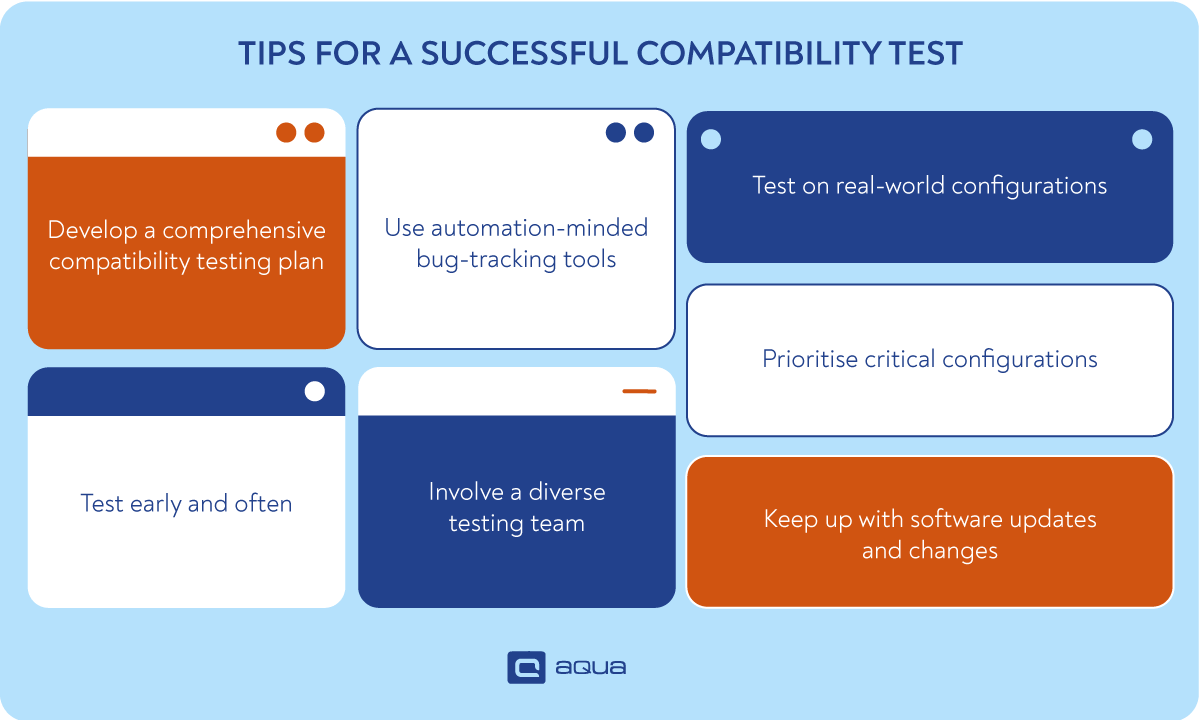In this article, we’ll explore compatibility testing, its importance, and real-world examples of its use in software development. So, whether you’re a developer or a tech-savvy user, embrace yourselves; we will dive deep into the topic.
What is software compatibility testing?
Software compatibility testing checks whether the software is compatible with various devices, operating systems, and platforms. The goal of compatibility testing is to ensure the software works flawlessly on a wide range of systems and devices, providing a seamless user experience.
When validating compatibility, you should test the software on different configurations of hardware and software, including operating systems, web browsers, mobile devices, and other platforms. The tests are designed to identify potential compatibility issues like software bugs or conflicts with other applications.
Compatibility testing in software testing is crucial to deliver a product that meets a diverse user base’s needs. Without it, the software may not work as intended on certain platforms, leading to negative user experiences, lost revenue, and damage to your reputation.
If you want to do backend and frontend compatibility testing, design the backend and frontend in such a way that they can't possibly be misaligned. This is why we have things like schemas and design-by-contract. Then just make some basic e2e tests as a double check.
Importance of software compatibility testing
A software compatibility test is crucial for several reasons:
- Ensures smooth user experience: A well-done compatibility testing guarantees smooth functionality across various devices, operating systems, and platforms, leading to users having a hassle-free experience with the software, regardless of the device or system they use.
- Increases customer satisfaction: Delivering compatible software with various devices and systems increases customer satisfaction and loyalty. Users would rather stick with software that works smoothly and consistently across all their devices than switch to a different software due to compatibility issues.
- Saves time and resources: If you conduct compatibility testing early in the development process, you can identify and fix potential issues before release, saving time and resources in the long run.
- Boosts Software Reliability: Extensive compatibility testing guarantees functionality and increases the software’s dependability. Early resolution of compatibility issues helps you produce a more dependable and stable product. Users get confidence from this dependability since they know they can count on the software to function consistently and successfully in various settings.
Types of software compatibility testing
Several types of software compatibility testing can be performed, including:
- Operating system compatibility testing checks whether the software works correctly on different versions of the operating system, such as Windows, Linux, or macOS.
- Browser compatibility testing ensures the software works correctly on different web browsers, such as Chrome, Safari, Firefox, or Edge.
- Mobile device compatibility testing ensures the software works correctly on mobile devices like smartphones and tablets with various operating systems, screen sizes, and resolutions.
- Hardware compatibility testing checks the software’s performance with different hardware configurations, such as CPU instructions or hard RAM requirements.
- Network compatibility testing ensures that the software works correctly with different network configurations, such as different types of routers, firewalls, and proxies.
- Database compatibility testing checks whether the software works well with databases like MySQL, Oracle, or Microsoft SQL Server.
- Third-party application compatibility testing ensures the software works correctly with different third-party applications like antivirus software or other security tools.
Apart from these, there are 2 types of compatibility testing in QA: forward compatibility testing checks whether the software is compatible with future versions, while backward compatibility testing checks whether it is compatible with older versions of hardware, software, or network configurations.
When it comes to ensuring your software runs seamlessly across various environments, understanding the differences between these environments is crucial. Each type addresses specific factors that can impact your software’s performance and user experience, ensuring that it meets the users’ diverse needs.
What you also need to achieve these is a robust, modern Test Management System that can streamline as much as it can. With this type of solution, you can focus your efforts on what matters most and needs human insights.
This is where aqua cloud excels. With over 20 years of experience, aqua cloud is designed to support comprehensive compatibility testing across all platforms. It offers 100% visibility and traceability into your testing processes, allowing you to efficiently manage compatibility tests for various operating systems, browsers, mobile devices, and hardware configurations. Thanks to aqua’s AI-driven features, you can create and manage test cases in seconds. With aqua’s automation integrations, you can also execute compatibility tests seamlessly across multiple environments, ensuring that your software is not only compatible but also optimised for performance.
Achieve 100% flawless compatibility across all platforms with aqua cloud
When to perform compatibility testing?
Performing compatibility testing during the software development lifecycle, particularly during the testing phase, is crucial for identifying and resolving compatibility issues before the software release. This way, you can initiate compatibility testing as early as possible in the development process to proactively address any potential problems with different hardware, software, and network configurations. By conducting compatibility testing early, you can minimise the risk of last-minute surprises and ensure a smoother and more successful software launch. You should also perform compatibility testing whenever you release a new software version or change the system environment.
"Only conducting performance testing at the conclusion of system or functional testing is like conducting a diagnostic blood test on a patient who is already dead."
The process of software compatibility testing
When performing compatibility testing, make sure you go through the following stages:
- Identify the target environment for the software application by analysing the various hardware, software, and network configurations on which the software will be used.
- Create a test plan that outlines the scope and objectives of the compatibility testing, identifying the specific tests like functional testing, performance testing, and user acceptance testing.
- Implement automation by selecting appropriate tools and frameworks to automate the execution of compatibility tests. This effort includes automated configuration setup, test script creation, and result analysis.
- Execute the tests by installing and configuring the software application in the target environment and running compatibility tests to identify any issues or conflicts.
- Troubleshoot and resolve issues by making changes to the software application or the target environment to ensure the software is fully compatible.
- Document and report the results to the relevant stakeholders by creating a detailed report of the testing process that includes issues or conflicts and the steps taken to resolve them.
I believe you can use Cypress for compatibility testing, it works with electron, chrome and firefox. They don't have support for safari though, but you can create a pipeline where you test your site's features in multiple browsers and versions
Challenges in compatibility testing
There are several challenges that software development teams may encounter during the process of compatibility testing:
- Diverse configurations: With the increasing number of configurations in the market, it can be challenging to perform compatibility testing with all possible hardware and software configurations.
- Limited resources: Testing a software application for compatibility requires significant resources, including hardware, software, and testing expertise, which may not be available to all teams.
- Time constraints: QA compatibility testing can be time-consuming, especially when dealing with large and complex software applications, making it harder to perform in the intended timeframe.
- Dynamic environments: Software environments are constantly changing with new updates and upgrades affecting the compatibility that can be hard to keep up with. Minimising the impact requires tools and techniques for automatic environment provisioning, configuration management, and version control.
- Technical expertise: Compatibility testing requires vast technical expertise in hardware, software, and networking that not all software development teams may have.
Tips for successful compatibility test
Here are some tips for conducting successful software compatibility testing:
- Develop a comprehensive compatibility testing plan that covers all possible hardware and software configurations to ensure accurate results.
- Use automation-minded bug-tracking tools that can help you save time and resources, reduce errors, and increase test coverage.
- Test on real-world configurations that users may encounter to ensure the software application performs as expected.
- Prioritise critical configurations that users will most likely use to ensure the software application is fully compatible with the most important configurations.
- Test early and often to identify compatibility issues early on, reducing the risk of expensive and time-consuming fixes later.
- Involve a diverse testing team with varying levels of technical expertise to identify compatibility issues from different perspectives and increase the chances of finding critical issues.
- Keep up with software updates and changes to ensure the software application remains compatible with the latest technologies.

Compatibility testing example
Suppose you have developed a software application for a client that wants to run on their organization’s network. You need to perform compatibility testing to ensure that the software works correctly and without any issues across different configurations. Here is a use case you may follow:
Use Case: Mobile App Compatibility Testing
A mobile app development company has created a new social networking application for both Android and iOS platforms. The app aims to provide a seamless user experience across various devices, screen sizes, and OS versions.
To ensure compatibility, the testing team sets up a comprehensive test lab with various devices representing different manufacturers, models, screen sizes, and operating system versions. This includes popular devices like iPhones, Samsung Galaxy phones, Google Pixel phones, and more.
The compatibility testing process involves installing the mobile app on each device in the test lab and executing a series of tests. The tests cover different aspects, such as UI rendering, functionality, device-specific features, performance, and interoperability with other apps or system components.
Throughout the testing process, the team identifies compatibility issues, such as layout inconsistencies, crashes on specific devices, performance degradation on lower-end devices, or conflicts with other installed apps. Ultimately, they document these issues and collaborate with the development team to address and resolve them.
Example: Figma
Figma is a cloud-based design tool to create, collaborate, and share design projects. The tool needs to ensure compatibility across various operating systems (such as Windows, macOS, and Linux) and web browsers (such as Google Chrome, Mozilla Firefox, and Safari) to ensure a consistent user experience for its users.
During compatibility testing, the Figma testing team should set up different environments with various OS and browsers. They must verify that design projects render correctly, tools and features function as intended, and collaboration features work seamlessly across different platforms.
Compatibility testing will help identify issues specific to certain configurations and ensures that Figma provides a consistent design experience regardless of the platform user chooses.
Best compatibility testing tools
So you know the answer to the question, “What is compatibility testing?”. Now, you should also be able to pick the best tools for your requirements. Here is the list of the best compatibility testing tools you should try:
- BrowserStack: Users can test their online apps across various browsers and devices with BrowserStack, a popular cloud-based testing platform. It offers various OS and browser versions, making thorough compatibility tests easier. BrowserStack is popular among developers and testers because it offers actual device testing and connectors with well-known development and testing tools.
- Sauce Labs: Sauce Labs is the next cloud-based compatibility testing platform on our list that provides automated testing for web and mobile applications. It supports various browsers and platforms, helping you perform parallel testing and execute tests in the cloud. The tool is popular for its scalability and integration with popular testing frameworks.
- LambdaTest: LambdaTest is a cloud-based platform for cross-browser testing of web applications. It offers a wide range of browsers, including mobile browsers, and provides features such as screenshot testing, responsive testing, and automated testing. LambdaTest aims to simplify the testing process and enhance collaboration among your development and testing teams.
- Applitools: This tool specialises in visual testing and monitoring. It uses AI-powered visual comparison to detect visual bugs and differences in web and mobile applications. Applitools integrates with various testing frameworks and tools, providing a visual testing solution to ensure the visual correctness of applications across different browsers and devices.
- Browserling: The last name on our list is a cross-browser testing tool that allows users to test their websites interactively across different browsers. It provides a live testing environment where users can enter a website URL and instantly view how it renders on various browsers and operating systems. Browserling supports various browsers, including legacy versions, making it a handy tool for ensuring compatibility with older browser versions. With a simple and user-friendly interface, Browserling is suitable for quick and on-the-fly cross-browser testing. It also offers a screenshot API for automated testing and integration into the development workflow.
These tools ensure your web applications function seamlessly across various browsers and devices, minimising the risk of compatibility issues. They are excellent examples of software compatibility solutions that can streamline your testing processes, enhance collaboration, and deliver a consistent user experience across different environments. However, to truly optimise your testing efforts and achieve comprehensive compatibility across all platforms, you need a robust TMS that goes beyond compatibility and does all.
Let’s introduce aqua cloud. Being the first solution to bring AI to QA, aqua aims at just one goal: taking away the pain of testing. How? Here is what aqua brings to your table:
- A centralised repository for chaotic testing efforts, combining both manual and automated tasks
- Intelligent AI-Copilot that will guide you through 100% of your struggles
- A super-fast AI assistant that will save 98% of your time by creating requirements, test cases and data for you in seconds
- Native Capture integration for visually stunning bug reports
- 100% traceability and control for all your efforts
- 10+ robust automation and project management integrations that include Jira, Ranorex, Azure DevOps, UnixShell, Powershell, Jenkins
What else do you expect from a modern TMS? Just click below and start your transformation right away.
Go beyond software compatibility: achieve software perfection
Conclusion
Software compatibility testing is critical for ensuring your software works seamlessly and without issues in various environments. By identifying compatibility issues early on, you can save time and resources by fixing them before they get costly. By following the tips and best practices outlined in this article, you can perform a full compatibility test and deliver a better user experience to your customers.
If you’re a QA professional looking for a powerful and intelligent tool for your compatibility testing efforts, aqua cloud has everything you need. With its advanced automation and machine learning capabilities powered by GPT, aqua’s AI Copilot can help you create similar tests for different browsers and spot and remove duplicate tests with ease. It also enables you to identify and prioritise the most essential tests to maximise your testing efficiency. Whether you create tests manually or need assistance, aqua’s AI is the solution you’ve been looking for.
Reduce manual efforts and get the most out of your compatibility testing







